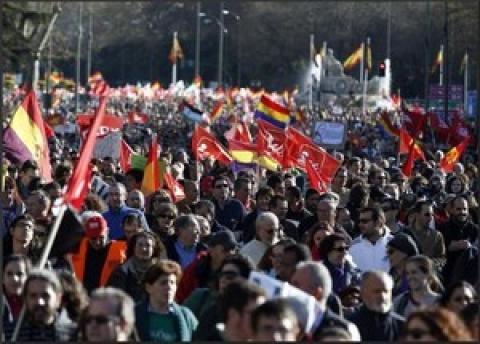Millions-Strong March for Dignity Shakes Spain
Once the March for Dignity became public, it rapidly became clear that it was an initiative for which millions had been waiting. Endorsements of its manifesto rapidly multiplied and the popularity of the initiative forced the mainstream union confederations to give it their blessing. No to the payment of the debt; bread, shelter and work; and not one more service cut.
All political forces in Spain are now straining to adjust to the huge 1 million to 2 million-strong March for Dignity demonstration in Madrid. On March 22, the march greeted the protest columns that had converged on Spain's capital from 12 outlying cities and towns over the previous week.
The enormous success of this initiative is still sinking in. How come an initiative that began outside the mainstream union confederations, the Workers Commissions (CCOO) and the General Workers Union (UGT), could mobilise so many people and eventually force them to declare their support?
One of the reasons was the very caution of CCOO and UGT leaders over the past year. After calling national days of action and two general strikes in 2011 and 2012, the mainstream confederations have been quiet for more than a year. They have been apparently concerned about their capacity to mobilise members in a phase of rising unemployment.

Madrid, March 22.
Green Left
They have been fearful of producing a flop that the People’s Party (PP) government of Prime Minister Mariano Rajoy could exploit to mount the next phase of its anti-union laws (being called for by the European Commission but so far hesitated over by Rajoy).
Regardless of whether there was any substance to this reasoning, the crisis has kept grinding on. It is ruining the livelihoods and futures of millions, especially as family savings run out.
By early this year, 650,000 households in the Spanish state were forced to survive with no income at all.
However, various groups have stepped into the leadership vacuum created by the paralysis of the CCOO’s and UGT.
The initial idea for the march came from the Dignity Camps set up in Extremadura, Spain’s westernmost state, with an unemployment rate running at 32.3%. The Dignity Camps arose from a protest outside the government employment office in the city of Merida. Protesters called for the creation of 25,000 public sector jobs and a guaranteed minimum income.
From this seed, a network rapidly grew to more than 300 collectives and social platforms, and thousands of individuals. Its demands expanded to cover the concerns of new participants, such as the Spanish state’s most well-known social movement, the Mortgage Victims Platform (PAH), and the various “tides” against health and education cuts.
A key actor in the movement has been Communist Party of Spain (PCE) Extremadura leader Manual Canada. He is convinced that, with the right tactics, the unemployed can become a source of social mobilisation. “The Dignity Camps are the working-class 15M (indignado) movement”, he is fond of saying.
Canada also shares the extra-institutional strategy of the Andalusian Workers Union (SAT), led by Jose Manuel Sanchez Gordillo, the mayor of the cooperative-based town of Marinaleda.
The SAT is famous in Spain for its raids on supermarkets to take food to feed the hungry, occupations of idle government lands and marches to dramatise its members' demands
The first Dignity March took place in Extremadura in September last year. At the time, the leaders of the Dignity Camps also established links with the Civic Front (We’re the Majority) of former United Left national coordinator Julio Anguita.
With this broader leadership in place, and joined by others such as leading members of ATTAC (Association for the Taxation of Financial Transactions for the Aid of Citizens), the planning for the national March for Dignity began late last year.
It made use of the resources and structures of sympathetic unions and the United Left, the main force to the left of the social democratic Spanish Socialist Workers Party (PSOE).
Once the March for Dignity became public, it rapidly became clear that it was an initiative for which millions had been waiting. Endorsements of its manifesto rapidly multiplied and the popularity of the initiative forced the mainstream union confederations to give it their blessing.
It has been estimated that those who completed the actual marches to Madrid can be counted in the thousands, with the Andalusia column, led by the SAT, the biggest. However, the warm reception these columns received as they passed from one unemployment-stricken regional town to the next was confirmation that they were speaking for millions.
The popular reception reached a crescendo in Madrid. This was registered first when the columns were quartered in various working-class suburbs. But it was on full display on March 22, when hundreds of thousands came from regional Spain to join the hundreds of thousands more Madrid citizens in welcoming the marchers.
However, mainstream TV coverage of the event concentrated on the violent end-of-demonstration clash between the police and what were probably provocateurs (who were disowned by the March for Dignity’s organising collective).
The PP’s Madrid regional premier then likened the marchers to members of the Greek neo-Nazi outfit Golden Dawn. Central government representative in Madrid, Cristina Cifuentes, opened a legal case against its organisers with a view to bankrupting the group with court-imposed fines.
Gines Fernandez, amember of the coordinating collective, put his finger on the roots of these responses: “Cifuentes’ accusations show that, as the rap group 'Los Chikos del Maiz' say, fear is changing sides.
“The government representative and the government itself are trying to silence a massive and important protest which has managed to unite in Madrid people from all regions of the state with very concrete demands: No to the payment of the debt; bread, shelter and work; and not one more service cut.”
The next phase in the work of the March for Dignity will involve actions at the regional level, with the next national mobilisation tentatively planned for April.
[Dick Nichols is Green Left Weekly’s European correspondent. Read an English translation of the March for Dignity’s manifesto.]
Courtesy: portside.org
Disclaimer: The views expressed here are the author's personal views, and do not necessarily represent the views of Newsclick
Get the latest reports & analysis with people's perspective on Protests, movements & deep analytical videos, discussions of the current affairs in your Telegram app. Subscribe to NewsClick's Telegram channel & get Real-Time updates on stories, as they get published on our website.





















